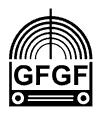Startseite » Magische Augen und mehr » Röhren, Transistoren und Bauelemente » unbekannte Röhre (spezielle Leistungsröhre)
| Aw: unbekannte Röhre [Beitrag #17169 ist eine Antwort auf Beitrag #17089] |
Di., 23 August 2022 17:48   |
 emilio946
emilio946
Beiträge: 6
Registriert: August 2022
|
|
|
|
Lieber Karl, liebe Forumsleser,
ich bin neu hier und spreche leider nicht genug deutsch. Bitte verzeihen Sie mir meinen englischen Beitrag unten.
As I told Wolfgang, the unknown electron tube is definitely a split-anode magnetron, similar as per operating principle to many other devices from the 1930s as the GE-MOV CW10. These magnetrons were superseded from 1940 onwards by cavity ones, but their use continued for niche applications, mainly microwave links and radar jammers. The GE family 5J29 to 5J33 was used in the AN/APT-4 from WWII well until the 1950s. Indeed, the geometry of the mystery tube looks similar to that of the 5J29 or even of the 5J33 (give a look at page 557 of Very High Frequency Techniques, vol. II, Harvard Radio Research Labs.)
http://www.ase-museoedelpro.org/Museo_Edelpro/Catalogo/tubes /docs_pdf/Very_High_Freq_Techn_Chapt23.pdf
From the loaded photos, the look of this specimen however shows very unusual aspects. The large getter surface and the corrugated connections of the anode halves to the outside, never encountered before, clearly indicating that it was designed to operate at high anode temperatures and therefore at quite high average powers, say from 25 to 50 watts. Glass drop stiffeners on the output connections show that it had to operate in presence of considerable vibrations. The whole execution looks remarkably well done, as does the whole design. The accuracy that we see would lead to exclude the hypothesis of an experimental magnetron, of the type used by CEMA (Gesellschaft für elektroakustische und mechanische Apparat) in its early experiments around 1935. Likely at the date 25 or 50 watts were the maximum one could expect. Anyway soon later in the radar transmitter the magnetron was replaced by the more stable UHF triodes at least until 1943, after the capture of a British H2S set in the crash of a Stirling bomber near Rotterdam. I would also exclude GEMA because they used to permanently etch their codes on the glass bulb.
The manufacture of this magnetron would suggest of a German copy of the 5J29. The Allied bombers certainly carried radar jammers in their flights over Europe and almost certainly also these equipment were captured.
It could be very interesting to know more about this unusual tube: its operating frequency, the approximate year of manufacture and its manufacturer. By the way, it could well be manufactured in Russia, as the Institute 160 at Fryazino, were several German magnetrons were built after the end of the war
One thing is certain: this magnetron has aspects that differentiate it from the more than 120 types in the ase-museoedelpro collection and deserves more information. Several split-anode as well as squirrel-cage magnetrons can be found at the page below:
http://www.ase-museoedelpro.org/Museo_Edelpro/Catalogo/tubes /T06-3_magnetron.htm
Best regards,
Emilio946
|
|
|
|
aktuelle Zeit: Di. Apr. 23 11:42:29 CEST 2024
|
 Das GFGF-Forum
Das GFGF-Forum




